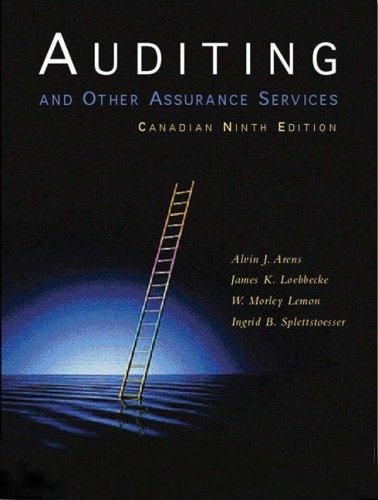The following questions refer to the use of sampling in auditing. For each one, select the best
Question:
The following questions refer to the use of sampling in auditing. For each one, select the best response.
a. Felix Santos decides to use stratified sampling. The basic reason for using stratified sampling rather than unre¬ stricted random sampling is to
(1) give every element in the population an equal chance of being included in the sample.
(2) reduce as much as possible the degree of variability in the overall population.
(3) allow the person selecting the sample to use his or her own judgment in deciding which elements should be included in the sample.
(4) reduce the required sample size from a nonhomoge- neous population.
b. In an examination of financial statements, a public accountant will generally find sampling techniques to be most applicable to
(1) recomputing net wage and salary payments to employees.
(2) confirming accounts receivable for residential cus¬ tomers at a large electric utility.
(3) reviewing supporting documentation for additions to capita^assets
(4) tracing hours worked from the payroll summary back to the individual time cards.
c. From prior experience, a public accountant is aware that cash disbursements contain a few unusually large dis¬ bursements. In using statistical sampling, the public accountant's best course of action is to
(1) increase the sample size to lessen the effect of the unusually large disbursements.
(2) eliminate any unusually large disbursements that appear in the sample.
(3) continue to draw new samples until no unusually large disbursements appear in the sample.
(4) stratify the cash disbursements population so that the unusually large disbursements are reviewed sep¬ arately.
d. The auditor's failure to recognize an error in an amount or an error in an internal control data processing proce¬ dure is described as a
(1) standard error of the mean.
(2) statistical error.
(3) sampling error.
(4) nonsampling error.
e. An auditor makes separate tests of controls and tests of details of balances in the accounts payable area, which has good internal control. If the auditor uses statistical sampling for both of these tests, the acceptable risk estab¬ lished for the test of details of balances is normally (1) greater than that for tests of controls.
(2) less than that for tests of controls.
(3) the same as that for tests of controls.
(4) totally independent of that for tests of controls.
f. How should an auditor determine the tolerable misstate¬ ment required in establishing a statistical sampling plan?
(1) By the materiality of an allowable margin of error the auditor is willing to accept.
(2) By the amount of risk the auditor is willing to take that material misstatements will occur in the accounting process.
(3) By the amount of reliance the auditor will place on the results of the sample.
(4) By reliance on a table of random numbers.
Step by Step Answer:

Auditing And Other Assurance Services
ISBN: 9780130091246
9th Canadian Edition
Authors: Alvin Arens, James Loebbecke, W Lemon, Ingrid Splettstoesser




